Palm Line
 | |
| Subsidiary of United Africa Company (UAC) | |
| Industry | Shipping |
| Successor | Ocean Transport & Trading in 1985 |
| Founded | 1911, as Southern Whaling and Sealing Company Ltd |
| Defunct | 1986 |
| Headquarters | London, United Kingdom |
Area served | Northern Europe, West Africa and Mediterranean |
Key people | Frank Samuel (First Chairman) |
| Parent | Unilever |
The Palm Line was a UK-owned shipping line that was engaged in the West African trade from 1949, primarily servicing the ports along 5,000 miles of coastline from Morocco in the north to Angola in the far south. It ceased trading in 1986.
Palm Line was a member of both UK/West Africa Lines Joint Service (UKWAL) and Continent/West Africa Conference (COWAC) together with Elder Dempster, Black Star Line, Nigerian National Shipping Line, Guinea Gulf Line and Norwegian Hoegh Line.
Background
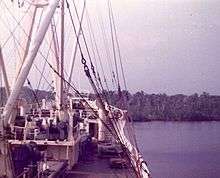
In the post-war period of the late 1940s, UAC decided to divest its shipping fleet to become an independent company in its own right. On 16 February 1949, an extraordinary general meeting of shareholders was held to set up the new company. This was done by reviving the dormant articles of association of the old Southern Whaling and Sealing Company, which Lever Bros. had bought in 1919 then sold to Christian Salvesen Ltd in 1941, and changing the name to Palm Line.
The name of the new company had not been decided upon without considerable discussion. At one stage the name Sun Line had been put forward. It was Mr Frank Samuel, later to become the new company's first chairman who thought of the name 'Palm'.
It is notable that all Palm Line ships, with the exception of Kano Palm and Katsina Palm, built before 1970 had to be less than 500 feet (150 m) long in order to navigate the creeks of Nigeria. Draught is another important feature. The coast of West Africa is extremely flat, and the slow-moving rivers and tidal currents have combined to build up long sand bars a mile or two off the coast. To enter most of the rivers, ships must pass over these bars; 27 feet (8.2 m) being the maximum draught to serve all ports. Even so, to enter many rivers, - for example the Escravos River which leads to Sapele - ships cannot carry more than 4,000 tons since the maximum draught to successfully make it over the Escravos Bar is limited to 17 feet (5.2 m), so vessels would often cross over the bar at the entrance to the adjacent Forcados River, then take the connecting creek to the Escravos River.
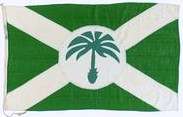
The early 1980s spelled the beginning of the end for Palm Line. From 1982 until 1986 the dramatic drop in Europe / West Africa trade meant the increasing need to charter the vessels out to third parties. Palm Line was sold to Ocean Fleets in 1986.
Emblem
The palm tree emblem had already been used on a Unilever Ltd house flag designed in 1939.
The Fleet
| Ship | Built | Speed (knots) | Type | GRT | Notes |
|---|---|---|---|---|---|
| MV Africa Palm | 1953 | 11 | General Cargo | 5,415 | Built by Short Bros, Sunderland. Sister ship to MV Burutu Palm (1953) Sold in 1972 to Panama and renamed Savoydean |
| MV Africa Palm | 1971 | 14 | General Cargo | 10,008 | ex-Joruna, purchased from Johansen & Knutsen, Oslo in 1974
In 1983 chartered and renamed Santa Barbara Pacific, then reverted to Africa Palm later in 1983 |
| MV Akassa Palm | 1958 | 14 | General Cargo | 9,000 | Built in Germany by Bremer Vulkan Sold in 1972 and renamed Elenma |
| MV Andoni Palm | 1958 | 14 | General Cargo | 9,000 | Built in Germany by Bremer Vulkan Sold in 1976 to Panama and renamed Mastro Manolis |
| MV Apapa Palm | 1973 | 16 | General Cargo | 9,417 | ex-MV Schauenburg.
 Built in 1973 by the H. Cegielski shipyard in Gdańsk, Poland as MV Schauenburg. Bought by Palm Line in 1977 from H. Schuldt (Hamburg) and renamed Apapa Palm. She was fitted with a Sulzer two-stroke diesel engine. She was one of a batch of six sister ships, two of which were the Shonga and Sherbro belonging to Elder Dempster Lines, part of Blue Funnel Line. The Ministry of Defence requisitioned both Shonga & Sherbro for duty in the Falklands War. At the time Apapa Palm was laid up in Antwerp. In 1985 sold to Venezuelan owners and renamed General Salom |
| MV Ashanti Palm | 1947 | General Cargo | 5,123 | ex-Ashantian 18 November 1962 sank in Naples harbour where she had arrived from Leghorn to load 400 tons of general cargo. She dragged her anchor in a fierce gale and drifted onto rocks surrounding the breakwater. There were no casualties. | |
| MV Badagry Palm | 1956 | 14 | General Cargo | 7,275 | Carried Dr. Kwame Nkrumah to London for the Commonwealth Prime Minister's Conference. Sold in 1972 to Cyprus and renamed Irene's Grace |
| MV Badagry Palm | 1979 | 16 | General Cargo | 12,279 |
Built in Sunderland. She carried the very last Doxford ship engine ever built; the J-type. |
| MV Bamenda Palm | 1956 | 14 | General Cargo | 7,200 | 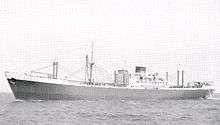 MV Bamenda Palm She changed her name twice, namely Elsa S K in 1978, and Eternal Sea in 1980, before being finally scrapped in May 1983. |
| MV Bamenda Palm | 1979 | 16 | General Cargo | 11,223 |
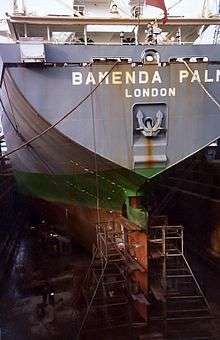 MV Bamenda Palm in Middle Docks, South Shields drydock undergoing conversion to Lloyd Texas Built by Hyundai of South Korea in 1979. In May 1984 she was chartered to Lloyd Brasiliero, Rio de Janeiro and renamed Lloyd Texas, whilst in Middle Docks dry dock, South Shields. As Lloyd Texas she sailed from South Shields to Teesport, Middlesbrough to load cement for the new RAF runway in Ascension Island. In 1985 she reverted to Bamenda Palm - from Lloyd Texas - and taken over by UAC. |
| SS Benin Palm | 1936 | General Cargo | 5,424 | ex-Ethiopian Sold in 1959 to Panama ( | |
| SS Burutu Palm | 1936 | General Cargo | 5,424 | ||
| MV Burutu Palm | 1953 | General Cargo | 5,410 | Built by Short Bros, Sunderland. Sister ship to MV Africa Palm (1953) Sold in 1967 to Astrocid Naviera of Piraeus and renamed Tyhi | |
| SS Dahomey Palm | 1937 | General Cargo | 4,876 | ex-Conakrian Sold in 1959 to Wallem & Co., Hong Kong and renamed Southern Mariner. | |
| MV Elmina Palm | 1957 | 14 | General Cargo | 8,088 |
The first British cargo ship to make extensive use of aluminium in her superstructure - which made an extra 55 tons available for cargo deadweight - and later Palm Line ships followed this design. Unlike the other ships built during this period, she was not fitted with 'deep tanks' for the carriage of vegetable oil. |
| MV Enugu Palm | 1958 | 14 | General Cargo | 7,963 | Sold in 1978 to Kuwait and renamed Athari |
| MV Gambia Palm | 1937 | General Cargo | 5,452 | _on_the_River_Mersey_in_front_of_Liverpool's_Liver_Building.jpg) MV Gambia Palm (1937) on the River Mersey in front of Liverpool's Liver Building ex-Gambian.
Built in Germany | |
| MV Ibadan Palm | 1959 | 14 | General Cargo | 8,950 | Built by Swan Hunter on the Tyne, and sister ship of the Ilorin Palm. She had a 4-cylinder 2-stroke Doxford engine. In 1978 she was sold to Kuwaiti owners and renamed Hind |
| MV Ikeja Palm | 1961 | 14 | General Cargo | 8,900 | Built at Swan Hunter shipyard, and sister ship of Ilesha Palm. She had a 4-cylinder 2-stroke Doxford engine. In 1981 she was sold to new owners who registered her in Panama and renamed her GME Palma |
| MV Ilesha Palm | 1961 | 14 | General Cargo | 8,900 | Built at Swan Hunter and sister ship of the Ikeja Palm. She had a 4-cylinder 2-stroke Doxford engine. MV Ilesha Palm (1961) In 1979 she was sold to Chaldeos Freighters Ltd of Greece. The new owners registered her in Liberia and renamed her Daphnemar. She was handed over in Bombay. |
| MV Ilorin Palm | 1960 | 14 | General Cargo | 8,950 |
Built by Swan Hunter and sister ship of the Ibadan Palm. She had a 4-cylinder 2-stroke Doxford engine. |
| SS Kano Palm | 1936 | General Cargo | 5,129 | ex-Guinean Sold in 1954 to Panama and renamed St.George, but registered in Greece | |
| MV Kano Palm | 1958 | 14¼ | General Cargo | 12,203 | Sold in 1979 to India and renamed Purna Shanti Sold in 1979 and renamed Island Trader |
| MV Katsina Palm | 1957 | 14¼ | General Cargo | 12,203 | Sold in 1978 to Singapore and renamed New Dragon |
| SS Kumasi Palm | 1943 | General Cargo | 7,221 | ex-Kumasian Sold in 1960 to Panama and renamed Flower | |
| SS Lagos Palm | 1947 | General Cargo | 5,047 | ex-Lagosian In 1960 renamed Oguta Palm then sold in 1964 to Greece and renamed Heraclitos. | |
| MV Lagos Palm | 1961 | 16 | General Cargo | 8,757 |
.jpg) MV Lagos Palm leaving Freetown, Sierra Leone in 1979 Built at Swan Hunter and sister ship of the Lobito Palm.
|
| MV Lagos Palm | 1982 | 16 | General Cargo | 15,575 | .jpg) MV Lagos Palm in the English Channel southbound 1984 chartered to Lloyd Brasileiro and renamed Lloyd Rio |
| MV Lobito Palm | 1960 | 16 | General Cargo | 8,807 | .jpg) MV Lobito Palm Built at Swan Hunter and sister ship of the Lagos Palm. |
| SS Lokoja Palm | 1947 | General Cargo | 5,135 |  SS Lokoja Palm (1947) ex-Zarian Sold in 1966 to Panama and renamed Despina L | |
| MV Lokoja Palm | 1982 | 16 | General Cargo | 15,576 |
Spent the majority of her short life with Palm Line chartered to the German company Woermann Line and renamed Wameru |
| MV Makeni Palm | 1951 | BVOC | ex-British Rover bought from British Petroleum in 1961 as a replacement for MV Opobo Palm Sold in 1967 to Panama and renamed Kerkennah. | ||
| MV Makurdi Palm | 1953 | BVOC | See MV Tema Palm | ||
| MV Matadi Palm | 1948 | BVOC | 6,246 | ex-Matadian Sold for scrap in February 1963 | |
| MV Matadi Palm | 1970 | 16 | BVOC | 13,700 |
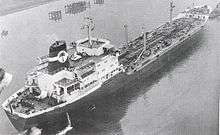 MV Matadi Palm A purpose-built BVOC, she carried refined vegetable oils such as rape seed oil from northern Europe to West Africa, and returned with mainly unrefined palm oil or coconut oil. She was built without double-bottoms for the cargo tanks, so although each tank had permanent steam coils installed - in order to maintain the oil at a constant carriage temperature of 96 °F (36 °C), with the temperature being raised to 110 °F (43 °C)-120 °F (49 °C) for discharge. This did not wholly compensate for the lack of a double-bottom and made discharging the unrefined oil in N.Europe during winter time more difficult. Getting the remainder of the expensive oil from the bottom of each tank was an arduous, manual and messy job called "puddling". She had a 4-cylinder 2-stroke Doxford engine. Only 483 feet (147 m) long, but with 28 separate tanks to carry several small parcels of oil cargo, for example, groundnut oil, palm kernel oil and palm oil may be shipped in different grades. In 1986 she was taken over by UAC and renamed Matadi. |
| SS Mendi Palm | 1936 | General Cargo | 5,419 | ex-Leonian Sold in 1959 to Panama and renamed Rio Yape | |
| SS Niger Palm | 1948 | General Cargo | 5,202 |
ex-Nigerian | |
| MV Oguta Palm | 1943 | General Cargo | 7,221 | ex-Lafian Sold in 1960 to Aristidis SS Co, Piraeues and renamed Aristoteles | |
| MV Opobo Palm | 1942 | BVOC | 6,083 | ex-Congonian. Built at Swan Hunters on the Tyne Sold 1961 to Windward Shipping Co., Hong Kong and renamed Winwar | |
| MV Sapele Palm | 1954 | General Cargo | Built in Bremerhaven, Germany Sailed under the German flag & operated by a subsidiary company Ölhandel-und Transport-Gesellshaft | ||
| MV Takoradi Palm | 1937 | General Cargo | 5,452 | ex-Takoradian. Built in Germany | |
| MV Tema Palm | 1953 | BVOC | 6,255 | Built in Germany Sailed under the German flag & operated by a subsidiary company Ölhandel-und Transport-Gesellshaft | |
| SS Volta Palm | 1936 | General Cargo | 5,129 | ex-Liberian Sold in 1954 to Finland and renamed Hermes | |
Bibliography
- Kohn, Roger (1970). Palm Line: The Coming of Age 1949–1970. London: Raithby, Lawrence and Company Ltd.
External links
- Swiggum, Susan; Kohli, Marjorie (24 October 2005). "Palm Line / United Africa Co.". The Ships List. Susan Swiggum & Stephen Morse.
- "Page Two". Palm Line. Merchant Navy Officers.
http://www.merchantnavyofficers.com/palm.html